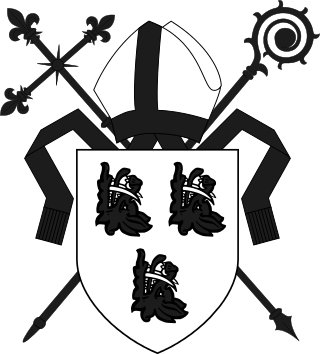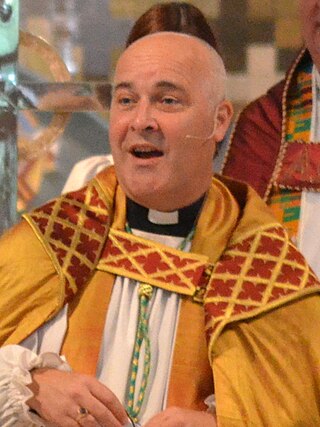Related Research Articles

Pope Gregory X, born Teobaldo Visconti, was head of the Catholic Church and ruler of the Papal States from 1 September 1271 to his death and was a member of the Secular Franciscan Order. He was elected at the conclusion of a papal election that ran from 1268 to 1271, the longest papal election in the history of the Catholic Church.

Pope Nicholas IV, born Girolamo Masci, was head of the Catholic Church and ruler of the Papal States from 22 February 1288 to his death on 4 April 1292. He was the first Franciscan to be elected pope.
Thomas Langton was chaplain to King Edward IV, before becoming successively Bishop of St David's, Bishop of Salisbury, Bishop of Winchester, and Archbishop-elect of Canterbury.

Roger Northburgh was a cleric, administrator and politician who was Bishop of Coventry and Lichfield from 1321 until his death. His was a stormy career as he was inevitably involved in many of the conflicts of his time: military, dynastic and ecclesiastical.
Walter Giffard was Lord Chancellor of England and Archbishop of York.
William de Wickwane was Archbishop of York, between the years 1279 and 1285.
John le Romeyn, died 1296, was a medieval Archbishop of York.
Henry of Newark was a medieval Archbishop of York.

Lawrence Booth served as Prince-Bishop of Durham and Lord Chancellor of England, before being appointed Archbishop of York.

The Archbishop of York is a senior bishop in the Church of England, second only to the archbishop of Canterbury. The archbishop is the diocesan bishop of the Diocese of York and the metropolitan bishop of the province of York, which covers the northern regions of England as well as the Isle of Man.
Simon Langton was an English medieval clergyman who served as Archdeacon of Canterbury from 1227 until his death in 1248. He had previously been Archbishop-elect of York, but the election was quashed by Pope Innocent III.
Stephen Bersted was a medieval Bishop of Chichester.

Gilbert de St Leonard was a medieval Bishop of Chichester.

Bentivenga dei Bentivenghi, O. Min., also written Bentivenga de Bentivengis or Bentivegna de' Bentivegni, was an Italian Franciscan and cardinal.
Napoleone Orsini was a Roman Cardinal. His ecclesiastical career lasted 57 years, 54 of them as a cardinal, and included six conclaves.
John of Tynemouth was a medieval English clergyman and canon lawyer. He was among the first teachers of canon law at what later became Oxford University, where he was by 1188. By the late 1190s John had joined the household of the Archbishop of Canterbury, Hubert Walter. Besides his position in the household, he also held a number of ecclesiastical positions, which earned him a substantial income. After Walter's death, John continued to serve as a lawyer as well as hold clerical offices. He died in 1221 and a number of his writings survive.
Burchard du Puiset was a medieval Anglo-Norman clergyman and treasurer of the diocese of York. Either the nephew or son of Hugh du Puiset, the Bishop of Durham, Burchard held a number of offices in the dioceses of York and Durham before being appointed treasurer by King Richard I of England in 1189. His appointment was opposed by the newly appointed Archbishop Geoffrey, which led to a long dispute between Geoffrey and Burchard that was not resolved until the mid 1190s. After the death of Hugh du Puiset, Burchard was a candidate for the Hugh's old bishopric, but lost out in the end to another candidate. Burchard died in 1196.
Gervasius Giançolet de Glincamp was born in the diocese of Mans, son of Gervais, great-grandson of Eudes, chevalier and seigneur de Groestel. He was a Roman Catholic cardinal and diplomat. He had a brother, Jean de Glincamp, who became Abbot of S. Remi in Reims. Another relative, a first-cousin, Robert de Glincamp, was bishop of Mans (1298-1309).

Matteo Rosso Orsini, was a Roman aristocrat, politician, diplomat, and Roman Catholic Cardinal. He was the nephew of Pope Nicholas III (1277-1280).

Guillaume de Bray was a French ecclesiastic and Roman Catholic Cardinal, poet, and mathematician.
References
- ↑ Reginald Lane Poole (ed.), Anecdota Oxoniensia 9 (Oxford 1902), p. 170.
- ↑ A. Paravicini Bagliani, "A proposito dell' insegnamento di medicina allo studium curiae," Studi sul XIV secolo in memoria di Anneliese Maier (ed. Alfonso Maierù and Agostino Paravicini Bagliani) (Roma 1981), pp. 400-405.
- ↑ A. Little, The Grey Friars at Oxford (Oxford 1892), Appendix C, pp. 76-77 and 331, 333.
- ↑ John Le Neve, Fasti Ecclesiae Anglicanae III, p. 74; the appointment was made by Bishop Godfrey Giffard (1268-1302), brother of Archbishop Walter Gifford of York.
- ↑ J. W. Willis Bund (editor), Episcopal Registers, Diocese of Worcester. Register of Bishop Godfrey Giffard, September 23rd, 1268 to August 15th, 1301 Volume II (Oxford 1902), p. 74.
- ↑ Register of Bishop Godfrey Gifford II, p. 85.
- ↑ He was Rector of Welton and Hemingbrough in the Diocese of York, appointed by Archbishop Giffard (1266-1279): Register of Walter Giffard, Archbishop of York, pp. 56 and 57. He was also Prebendary of Bugthorpe in the Cathedral of York, appointed on 11 November 1279: John Le Neve, Fasti Ecclesiae Anglicanae III, p. 178.
- ↑ Jules Gay (editor), Registres de Nicolas III (Paris 1898), 559; W. H. Bliss (editor), Calendar of Papal Registers I (London 1893), p. 459; Le Neve Fasti Ecclesiae Anglicanae III, p. 103.
- ↑ W. Brown (ed.), The Register of William Wickwane, Lord Archbishop of York (1279-1285) (Surtees Society 1907), p. 22.
- ↑ The Register of William Wickwane, p. 183.
- 1 2 Bellenger, Dominic Aidan; Fletcher, Stella (2001). Princes of the Church: A History of the English Cardinals. Stroud, UK: Sutton. p. 173. ISBN 0-7509-2630-9.
- ↑ Registres de Martin IV, no. 132, p. 50; Bliss, Calendar of Papal Registers I, p. 464
- ↑ Sede Vacante and Conclave of 1-2 April 1285 (Dr. J. P. Adams).
- ↑ Conrad Eubel Hierarchia Catholica medii aevi I second edition (1913), 10 n. 11.
- ↑ Sede Vacante and Conclave of 1287--1288 (Dr. J. P. Adams).
- ↑ Robert Brentano, Two Churches: England and Italy in the Thirteenth Century (Princeton 1968), pp. 53-56.
- ↑ Brentano, Two Churches, p. 54.
- ↑ Lorenzo Cardella, Memorie de' cardinali della Chiesa Romana santa II (Roma: Pagliarini 1793), pp. 22-23. It is alleged in the Annales Wigorniae, H. R. Luard (ed.) Annales Monastici Vol. IV (London 1869), pp. 493-494, that he was poisoned. The Annales Wigorniae also give the date of his death, vi kal. Augusti.